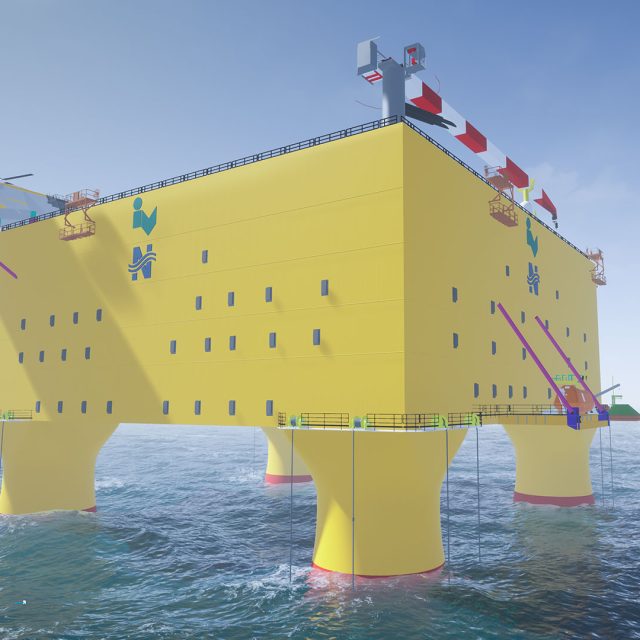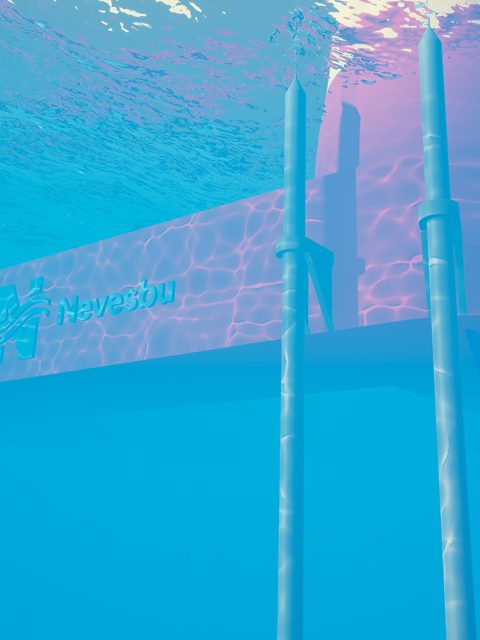Concept design of a floating offshore substation
Worldwide, the best wind conditions for generating wind energy are often found at sea in areas with deeper waters. The question is: how can this be achieved as efficiently, reliably, and affordably as possible? At water depths beyond 150 metres, the costs of the renowned 'bottom-founded' structures (such as transformer and converter platforms and wind turbines that are anchored to the seabed via a structure) increase exponentially, making floating solutions an interesting option. Nevesbu and Iv-Offshore & Energy jointly developed a concept for an offshore substation. A concept with potential.

Studies show potential
Lennart Buitendijk, Naval Architect at Nevesbu, is one of the initiators of the concept and tells us more about the realisation. “Nevesbu and Iv-Offshore & Energy consistently carry out innovative studies. In view of the oncoming energy transition, Nevesbu began investigating which unique floating applications could be devised to provide a solution. There are already many concepts for floating turbines, but not for a floating substation. We formed a joint initiative as Iv-Offshore & Energy has already designed many offshore wind substations, and Nevesbu has specialist knowledge of floating structures. The challenges presented with this type of floating solution include the lifespan of the dynamic power cables and the allowable motions of the transformers, rectifiers, and associated systems. Floating an offshore converter station weighing roughly 10,000 tonnes with minimal motions is a complex challenge, but our studies show that it is possible.”

Suitable deepwater areas
In Europe, the Mediterranean, North Sea, Bay of Biscay, and the Aegean Sea, in particular, are deepwater areas that are very suitable for generating wind energy. Especially in the area above Scotland and the United Kingdom towards Norway and Denmark, there are almost continuous strong winds. The concept that Nevesbu and Iv-Offshore & Energy have developed is therefore designed for the harsh weather conditions that are characteristic of these areas. The concept also minimises the impact on marine life.
Design principles
Some essential principles for the design of the floating transformer platform are: the concept must conform to the set requirements for wind energy at sea, it must not be too heavy in steel weight and must not be complex in terms of fabrication, safety, and reliability must also be guaranteed, it must be possible to guarantee a very high availability, and the platform must have a lifespan of at least 30 years. In addition, the social costs of supplying sustainable electricity must remain affordable, and the solution itself should therefore not be too expensive in terms of costs.
From static to dynamic
The most significant challenge is the transition from a static bottom-founded platform to a dynamic floating platform. Wind turbines must be capable of operating in conditions up to Beaufort 8, which means that the floating platform must continue to function when contending with waves of 8 to 12 metres high. Existing high-voltage (HV) equipment, however, is not suitable for high accelerations. To guarantee motions are kept to a minimum, motion analyses were carried out to calculate how different models behave at sea in strong winds with high waves. These analyses are based on the roughest seas in the world, such as the North Atlantic Gulf Region, the Bay of Biscay and the sea near Santa Barbara, California. If the concept is suitable for these waters, it can certainly also be applied in calmer waters.
The concept of the floating platform is designed in such a way that it can be applied in water depths in excess of 150 metres and with minimal vertical motion in sea conditions. The HVDC platform has a deck area of 85 by 85 metres and is positioned approximately 20 metres above the water’s surface. When the platform is installed at sea, it will be held in position with the help of so-called ‘tendons’ that are vertically anchored to the seabed. The floating structure is designed to minimise the vertical motions, which also reduces the loads on the export cables suspended below the platform. Tuning the motion behaviour of the platform for different water depths and wave conditions is also relatively simple.
Continual development
The concept has now been thoroughly worked out and appears to be feasible. So what is still needed to realise this concept at sea? Lennart explains: “We are currently busy with a design check and have now carried out various studies that have provided insight into the possibilities and most appropriate application for use in deepwater areas. We now also know what is important for the success of the design. The design check takes all this insight into account, and we are investigating how the design can be further improved and made more (cost) efficient. So we’re delving a little deeper. The basis is there, and we are now examining which parts are satisfactory and which may need further development or research. Finally, of course, we are hoping that there is a developer that will see the same potential in this concept as we, and thus develop the concept further together and put it into practice.”
Related articles
Would you like to know more about our floating offshore substation concept?
